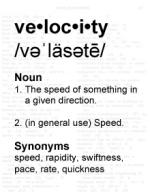|
This section contains 283 words (approx. 1 page at 300 words per page) |
The kinematic quantities of distance and velocity are some of the most basic concepts in introductory physics. The differential of each of these quantities is very important in kinematics equations, used to calculate the motion of traveling bodies.
Differentiating these quantities has some of the most conceptually useful results in basic physics. The derivative of distance over time is simply velocity, since the definition of velocity is the rate of change of distance (or position) over time. Differentiating velocity, or taking the second derivative of position, results in acceleration, defined as the rate of change of velocity over time.
The differentiated form of these terms can be either a function or a specific value. If it is a function, the instantaneous acceleration or velocity can be obtained by substituting a specific time value into the function.
The derivatives of distance and velocity may give insight into the behavior of the system. For example, if the system is under constant acceleration over time, the velocity term will be a linear term and the distance will contain a quadratic term, so that the derivatives come out to a constant. Further, taking the second derivative of a periodic motion function will indicate that this function's acceleration and position are greatest at the same time, while velocity is precisely out of phase with them. This kind of information can be used to figure out the behavior of a system with these known parameters.
Kinematics equations are often the first lesson learned in introductory physics classes. Studying them in more mathematically sophisticated terms of differentials of distance and velocity can provide a deeper insight into the physics of the problem.
|
This section contains 283 words (approx. 1 page at 300 words per page) |


